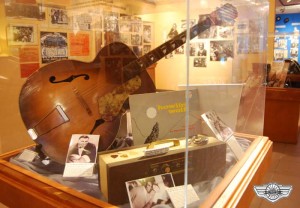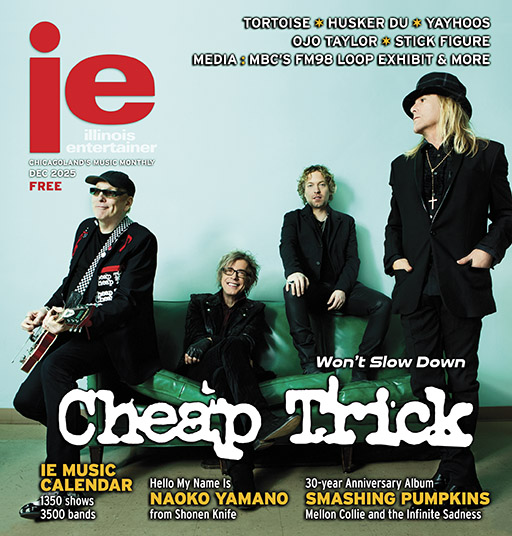Sweet Home: December 2009
Soul Of Bronzeville

Chicago’s connection to the blues runs about as deep as the Mississippi. From Chess Records to the legendary clubs that line the 47th Street blues district, Chicago has played a significant role in the development of the blues. The Chicago Blues Museum exhibit “The Soul Of Bronzeville: The Regal, Club Delisa And The Blues,” at the DuSable Museum, documents the elements that helped create blues and jazz history.
Before you can even step into the exhibit, you’re presented with a tantalizing array of historical photos and posters that demand closer inspection. A black-and-white photo labeled “The Blues Kings” shows B.B. King and Muddy Waters commiserating backstage at the Regal Theater in 1965. A Checkerboard Lounge poster advertises the unbelievable lineup of Waters, Junior Wells, Buddy Guy, and The Rolling Stones on an electric blue background. Another poster promotes King, Bobby “Blue” Bland, Little Milton, Albert King, and Junior Parker live at the Regal. It’s enough to drive any blues fan insane with the images of blues legends playing in their heads.
“We have over 7,000 photos,” says Gregg Parker, founder of the Chicago Blues Museum, explaining the depth of the museum’s memorabilia collection. We couldn’t even get half of our stuff in the space,” he says. While there’s talk of a second part to the exhaustive display, the current exhibit acts as a lively blues and jazz primer.
The neighborhood of Bronzeville stretched seven miles long and a half mile wide, from 22nd Street to 63rd between Wentworth and Cottage Grove during the 1940s. It was a city within a city and the second largest concentration of black people in the country. As more and more fled the South during the Great Migration North, they brought along the music and traditions that would expand the blues onto another, electrified, level.
During the ’30s through the late ’50s, the cultural hub of Bronzeville was the area around 47th and South Parkway, which would later be dubbed “the blues district.” It hosted pivotal jazz and blues clubs such as the Savoy Ballroom, The Regal Theater, and Club Delisa. The Savoy was the most elegant and elaborate, with a three-story entertainment complex that included the theater, ballroom, a department store, drug store, bowling alley, billiard rooms, and offices. The Savoy showcased jazz greats like Louis Armstrong, Count Basie, Duke Ellington, Louis Jordan, and Ella Fitzgerald.
The Regal was built with a blend of Moorish, Spanish, and Middle Eastern motifs, including a ceiling designed to look like a huge canopy supported by gilded poles. The theater held 12 to 15 shows a year, usually lasting seven days, which featured live music, a dance act, sometimes a gospel act, and always a comedian. Regular performers included Billie Holiday, B.B. King, T Bone Walker, Etta James, Ray Charles, Little Walter, Big Maybelle, and the Queen Of The Blues, Dinah Washington, who was discovered during a Regal amateur contest.
Club Delisa boasted 1,000 auditorium seats, a reputation for prestigious acts, and a façade of glazed white bricks offset by red fluorescent light bulbs on the inside. Swing master Fletcher Henderson directed the in-house orchestra and the dancefloor was hydraulically raised to the bandstand at the start of the floor show. Joe Williams, Sun Ra, and LaVern Baker regularly headlined the Delisa.
The exhibit highlights terra cotta blocks from the Regal Theater façade as well as red upholstered seats from the ’50s and a microphone from the ’40s. Towards the end of the exhibit, a cavalcade of choice blues artifacts beckons. A booth from the Checkerboard Lounge, complete with stables and worn chairs, fills a corner. A sign urging “absolutely no profanity of any kind. If the above rules are not followed, you will be fined” hangs to the side. Busts of B.B. King and Honeyboy Edwards fill glass showcases. A wall of Chicago blues legends displays Sonny Boy Williamson tipping his hat, Howlin’ Wolf in front of the mic at Chess Records, and Big Bill Broonzy posed with his guitar on his lap.
An old RCA TV plays archival footage from the Checkerboard and other Chicago blues clubs from the 1940s through 2003. A showcase features Howlin’ Wolf’s guitar with his Moanin’ In The Moonlight album and on the other side rests Little Walter’s butterfly harmonica and Junior Wells’ Green Bullet mic. One of the most insightful layouts reveals Jimmy Rogers‘ Gibson ES stereo guitar along with his blue rhinestone cuff links, dice, and a lighter resembling a clock.
Topping everything off, a curtained film room plays footage from ’40s jazz bands, ’50s blues acts, and ’60s Motown performances. The exhibit explores five decades of blues and jazz history and it requires approximately three hours just to view the offerings casually. According to Parker, who founded the museum in 1991, there’s more to come. “We’ve got B.B.’s Lucille, we’ve got Jimmy Reed‘s guitar, we’ve got Michael Jackson‘s audition tape from the Regal,” he says. “We’re also planning a blues museum restaurant with old TVs and jukeboxes so you can eat and see blues performances. That’s scheduled to open in Bucktown next year.”
“The Soul Of Bronzeville: The Regal, Club Delisa And The Blues” exhibit runs at the DuSable Museum, 740 E. 56th Place, through December 13th. Call (773) 947-0600 for hours and visit www.dusablemuseum.org and www.chicagobluesmuseum.com for more info.
— Rosalind Cummings-Yeates
Category: Columns, Monthly, Sweet Home












I have been to two museums that I will never forget. The Route 66 in Joliet and The Blues Museum in Chicago, when you are there you feel the reality of where we came from and the awareness that true happiness comes frome the simple things in life. Ride the Route and listen to the music of America.